Featured Comment:
“Delicious! thank you for your help!”
– Helena
What is Nikujaga (Japanese Meat & Potato Stew)?
Nikujaga is a one-pot dish, quite similar to a simple meat stew. The name “nikujaga” (肉じゃが) combines the word “niku” (meat) with “jagaimo” (potato).
While the dish has quite a Western feel in terms of ingredients, the broth is packed with unique Japanese flavor. It can be eaten either as a main dish served with rice or even as a side to grilled fish, miso soup and pickles. It’s really quite versatile.
It is a beloved traditional Japanese home-style dish. It’s made with tasty ingredients like beef, potatoes, carrots, and onions. By simmering them together and seasoning with soy sauce, sugar, and mirin, the vegetables become tender and full of flavor.
With a delightful blend of sweetness and umami, this dish is adored by many. Enjoy it as a scrumptious side dish with rice or a satisfying side dish with your favorite drink.
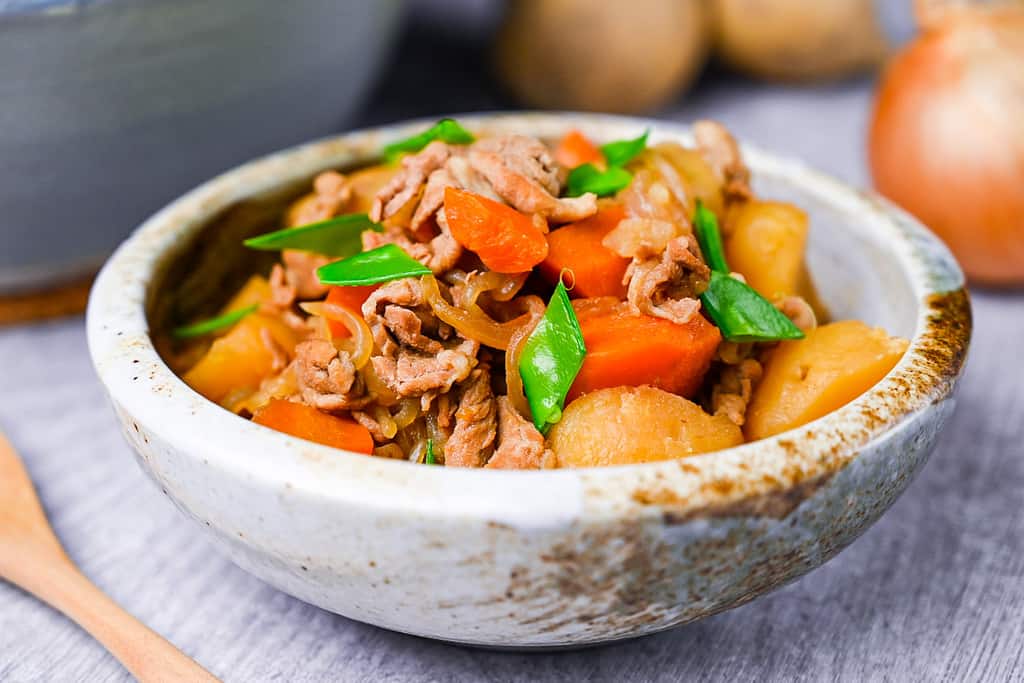
Ingredients & Substitution Ideas
- Thinly Sliced Pork: I’d go for pork shoulder or belly for this dish. I try to get the fat content just right. If there’s too much, it’ll be greasy, and if there’s too little, the meat will be dry and the broth won’t be as rich.
- Waxy Potatoes: Waxy potato varieties like new potatoes, Yukon Gold, or Charlotte are perfect for this recipe.
- Other Vegetables: The mix of carrots, onions, and snow peas.
- Dashi Broth: You can choose from my favorite homemade dashi, simple awase dashi, or vegan dashi recipes on the blog. If you’re short on time, instant dashi granules or dashi packets are a great quick alternative.
- Sugar: While regular white sugar is totally fine, I’ve been leaning towards light brown cane sugar lately.
- Mirin: If you want the most authentic flavor, look for “hon mirin” (本みりん).
- Sake: We’ve got two types of sake here: drinking sake (unsalted and suitable for drinking) and cooking sake (with added salt). I personally much prefer drinking sake.
- Konjac Noodles: You can leave them out if you can’t find them.
- Soy Sauce: For detailed brand recommendations and tips on selecting the perfect soy sauce for this dish, please check out my comprehensive soy sauce guide on the blog.
Variations: Alternative Ideas
Nikujaga can be adapted to suit your tastes. Although I like to make my recipe with pork, here are a few other ideas you can try!
- Beef nikujaga: Compared to pork nikujaga, beef nikujaga has a richer and more flavorful beef taste. If you want to enjoy the full flavor of the meat, beef nikujaga is the way to go. Thinly sliced chuck eye rolls, often used in shabu-shabu and sukiyaki, are typically used for this dish. The soft and fatty meat allows you to fully appreciate the beef’s flavor and richness, making it a great choice for chuck eye rolls. Be careful not to overcook the meat, as it can become tough if cooked too long.
- Chicken nikujaga: While not as common as pork or beef, chicken is another option for making nikujaga. I suggest using bite-sized pieces of chicken thigh for the best results.
- Vegetarian nikujaga: To make a vegetarian-friendly version of this recipe, follow two simple steps. First, switch to a vegetarian broth, and second, remove the meat. You can also use mushrooms as a tasty substitute for pork or beef!
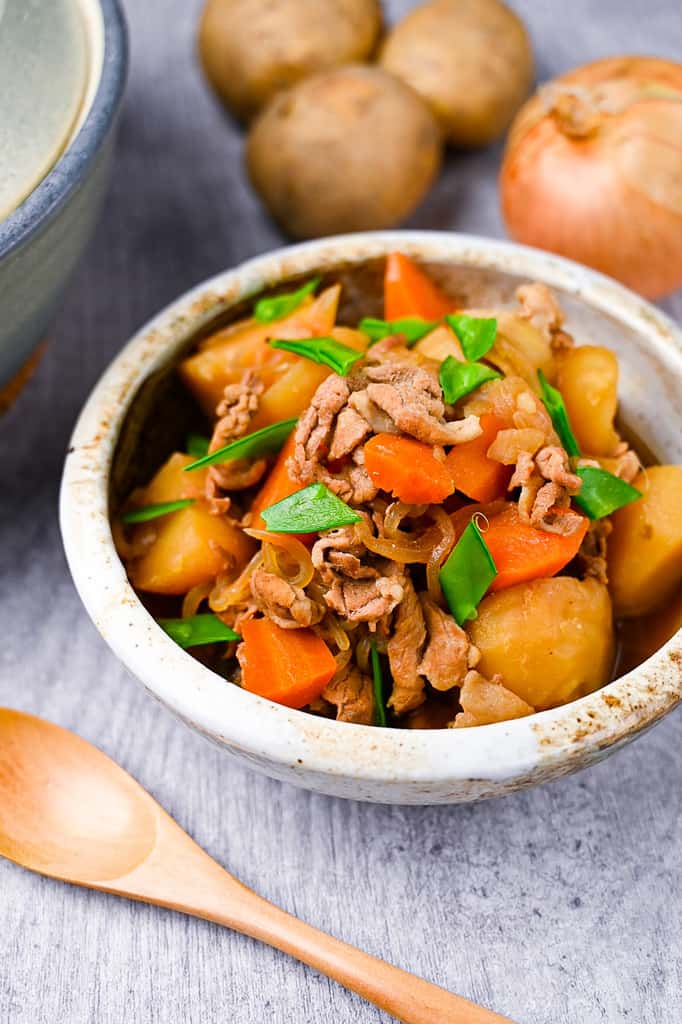
Visual Walkthrough & Tips
Here are my step-by-step instructions for how to make Authentic Nikujaga at home. For ingredient quantities and simplified instructions, scroll down for the Printable Recipe Card below.
If you prefer to watch the process in action, check out my YouTube video of this Nikujaga recipe for a complete visual walkthrough!
The first step is to peel the potatoes and cut them into halves or quarters (depending on the size). I recommend using a waxy type of potato, such as Yukon Gold or Charlotte, as they hold their shape better even after cooking for a long time.
Place the cut potatoes in a bowl of water to help remove the excess starch. This will prevent the broth from becoming thick or cloudy.
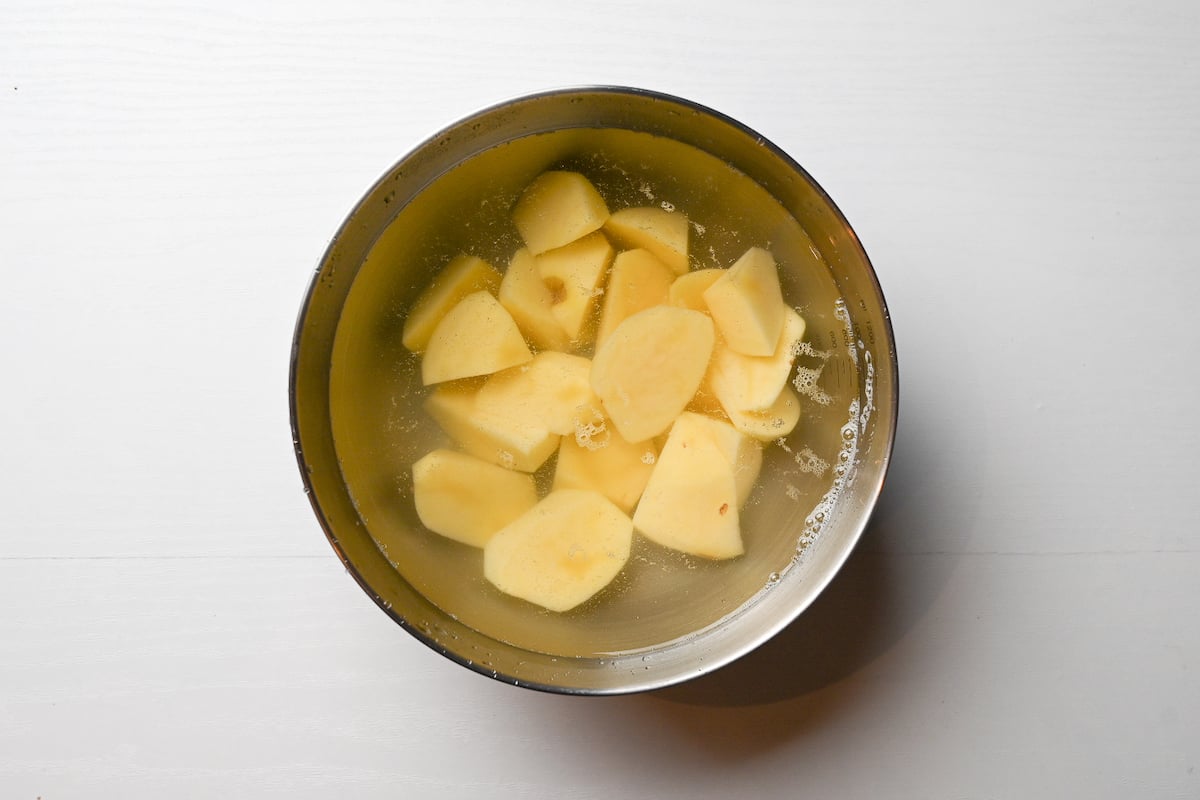
Peel the carrot and onion, then cut the carrot into small chunks and the onion into medium-sized wedges.
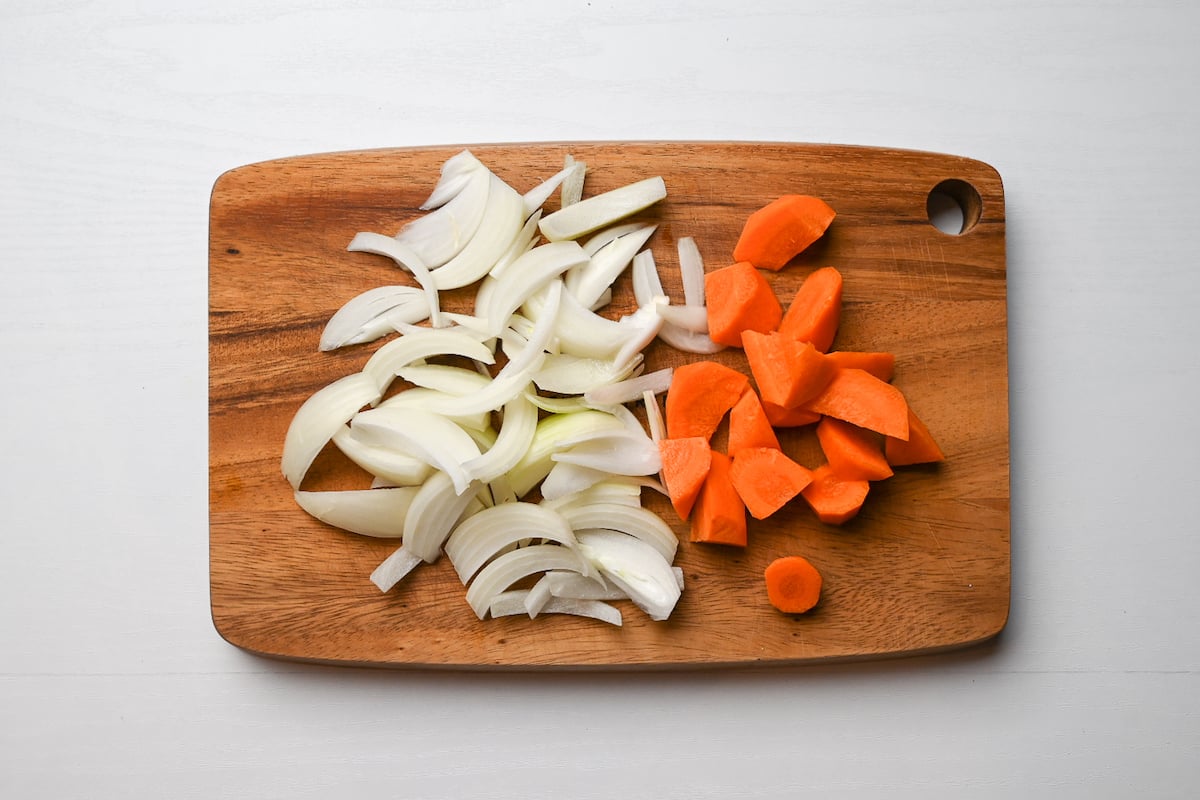
I recommend using thinly sliced pork (or beef) for this dish. Cut the slices into bitesize pieces.
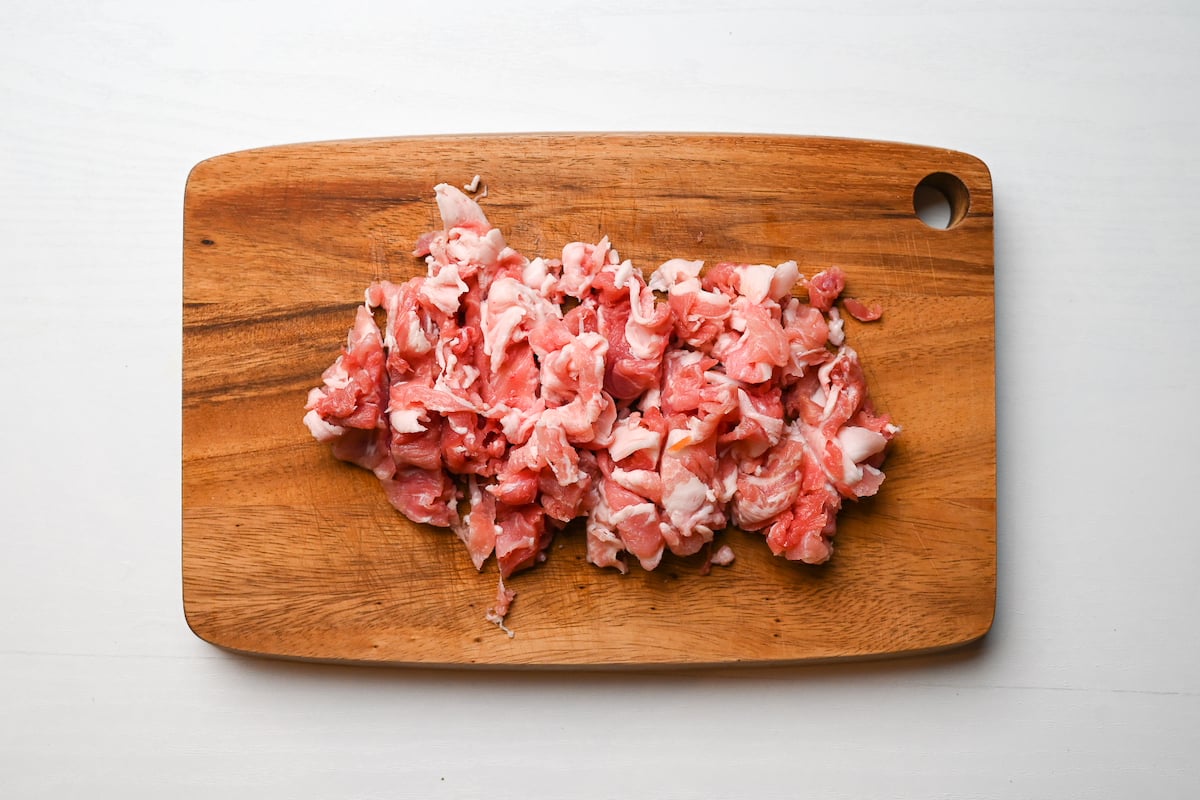
If you can’t buy thinly sliced pork or beef where you live, buy a block of meat, partially freeze it until firm (not frozen), and thinly slice it using a sharp knife. When the meat is half frozen, it’s easier to cut it thin without becoming misshapen.
Heat a medium to large pot on medium heat and once hot, add a drizzle of oil. Add the meat and sear on both sides. Once it’s seared, move straight onto the next step (if you fry the meat for too long, it can become tough or dry).
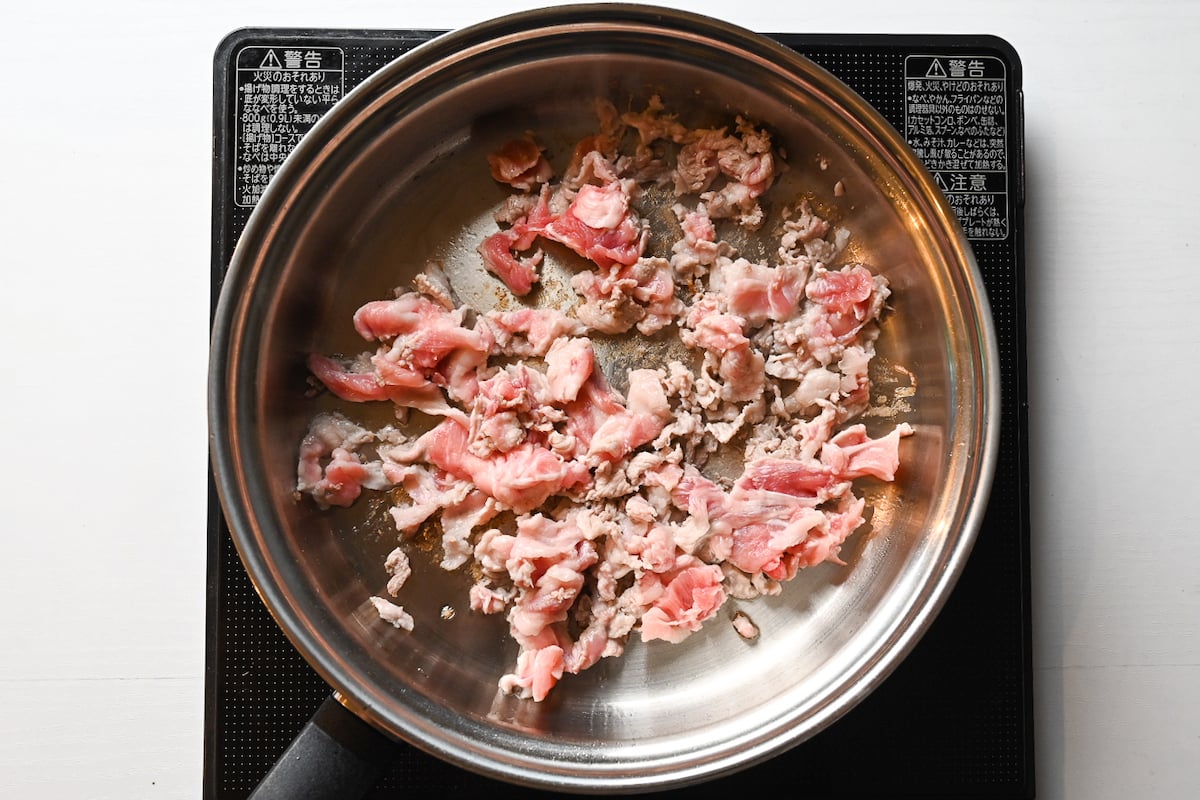
If the pot is too big, the broth will evaporate too quickly. On the other hand, if the pot is too small, the broth will not be evenly distributed, and some ingredients might become undercooked.
For this dish, ideally, use a medium pot that has a depth that allows the ingredients to come up to about halfway.
Once the meat is seared on both sides, add the onion and stir fry them for 1 minute.
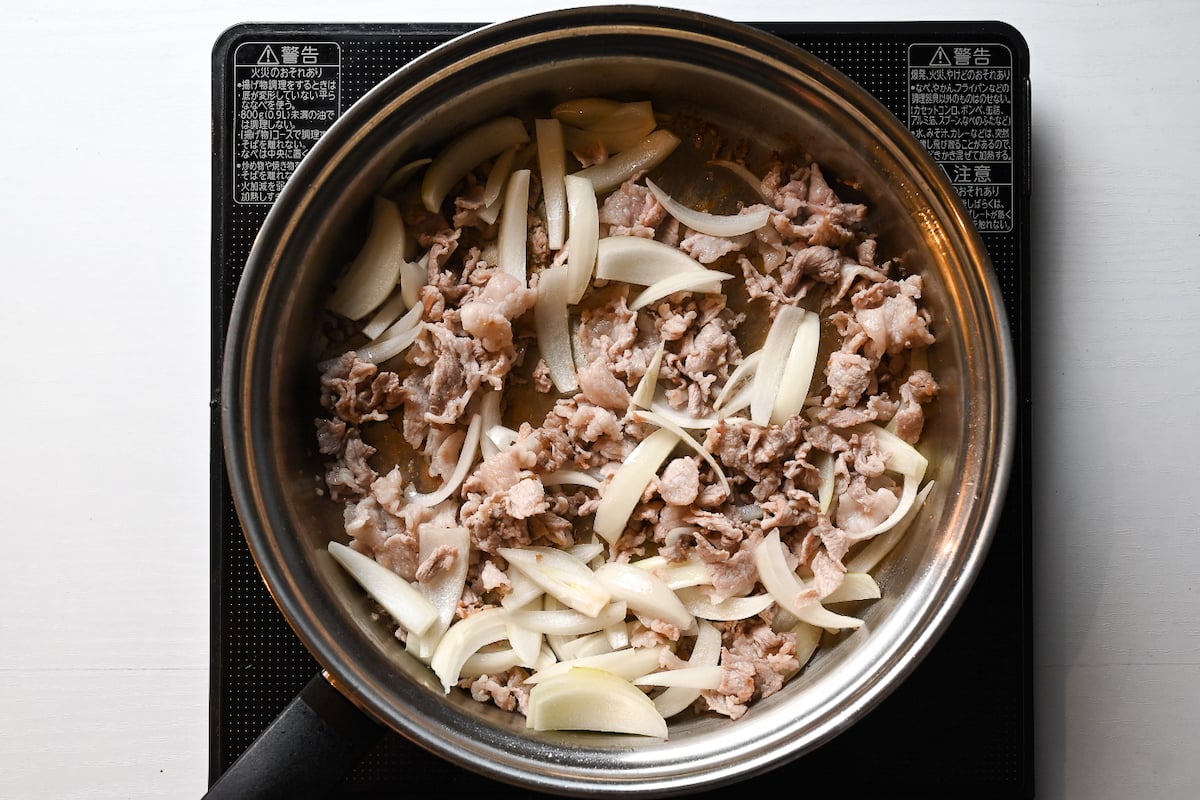
Next, add the carrots and potatoes and mix thoroughly.
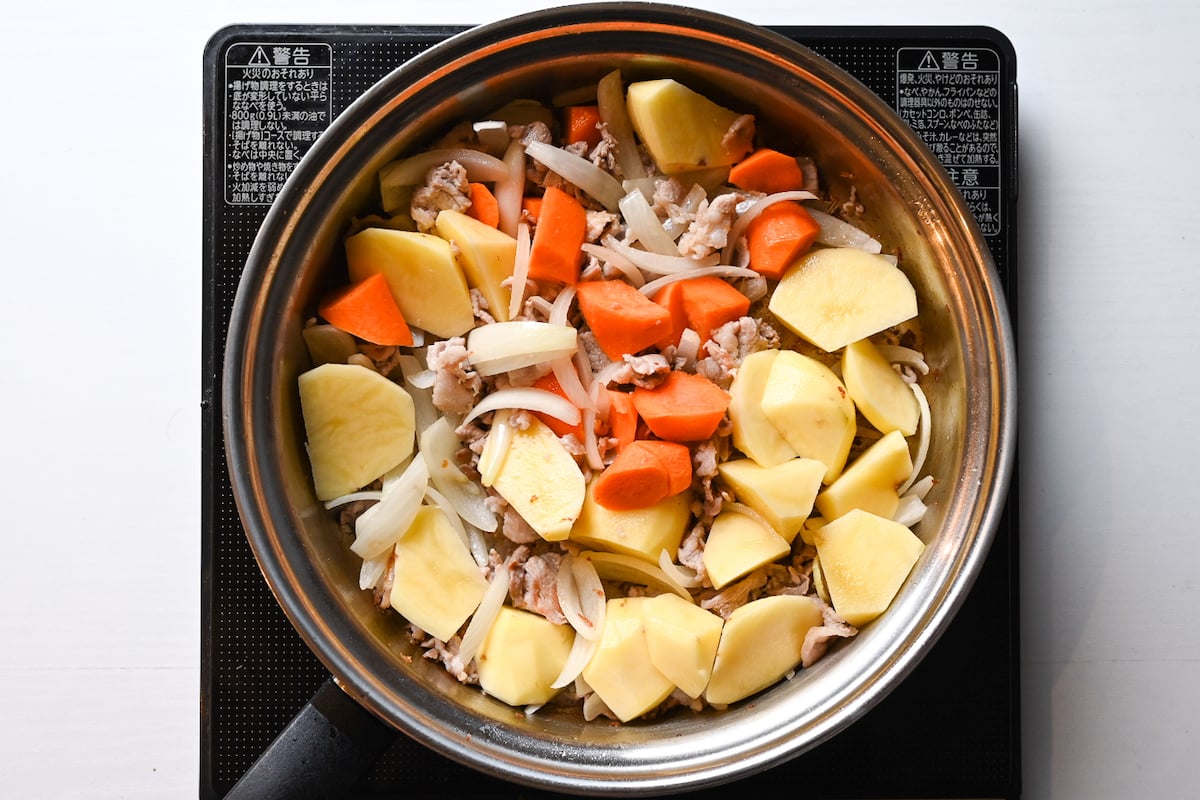
Sautéing vegetables with the meat first will help prevent them from falling apart and will also help bring out umami and savory flavors.
Next, add the dashi and bring it to a boil.
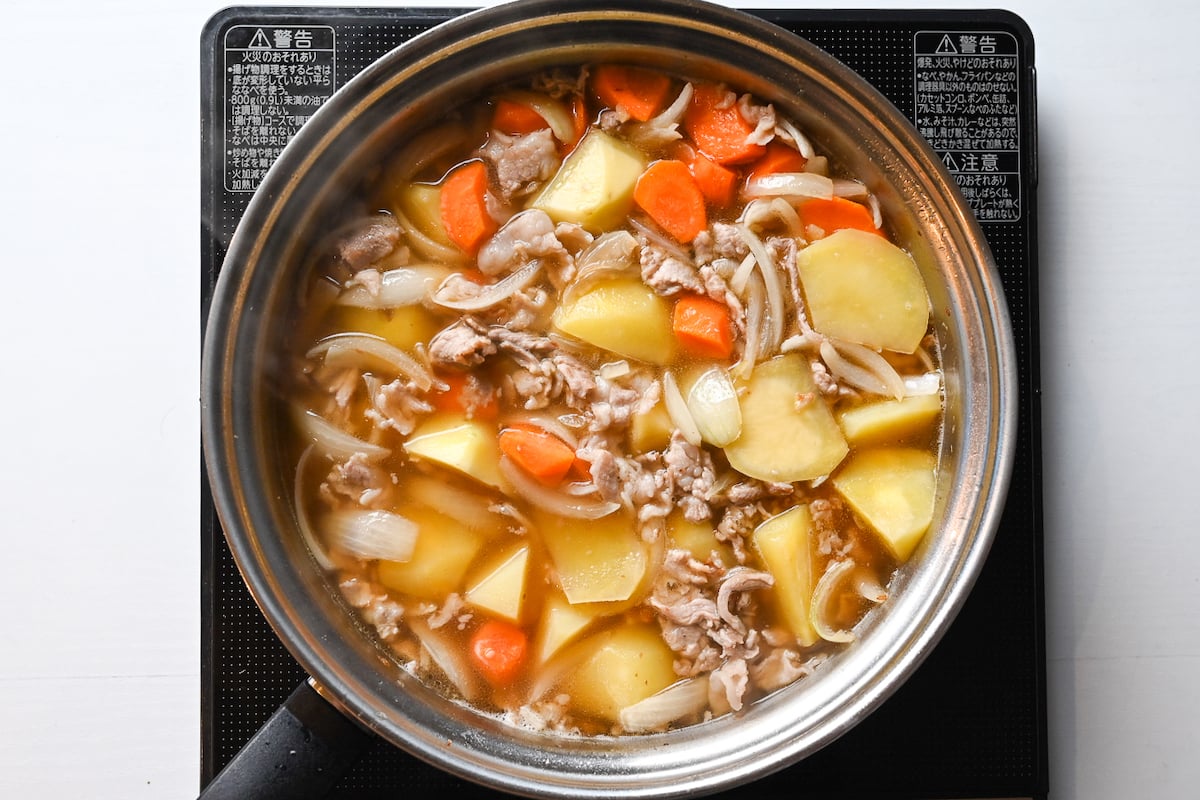
It’s important to use dashi for this recipe for the authentic Japanese taste.
Once the dashi is bubbling, add the light brown sugar, mirin and sake.
Reduce the heat to a simmer and place a drop lid on the top. I used a piece of scrunched up foil with a few holes poked in it this time, but you can use a wooden, steel or silicone drop lid or even learn how to make one with baking paper here. The drop lid should be touching the surface of the broth and ingredients.
Allow the nikujaga to simmer over a low heat for about 30 minutes.
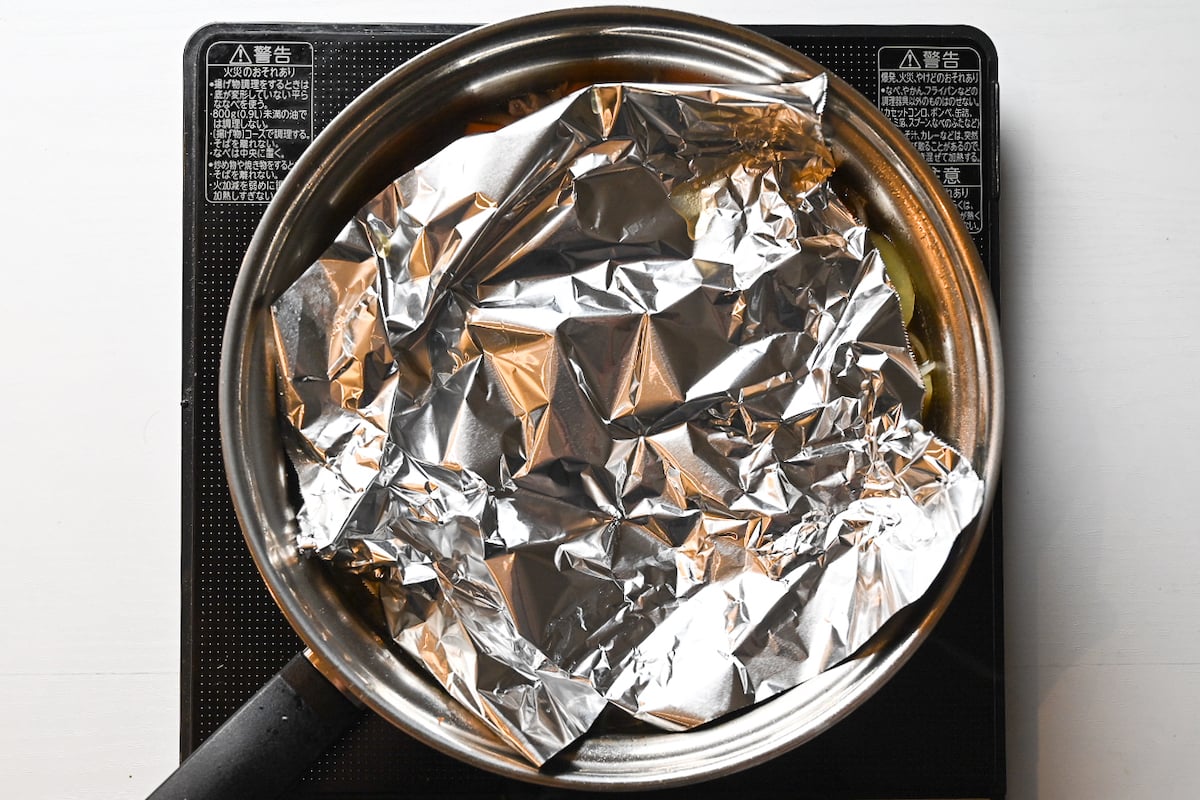
Nikujaga is made with a thin broth that is concentrated in flavor. It’s important not to add extra water. To help the ingredients cook evenly in less broth, we use an “otoshibuta” or “drop lid” in English.
A drop lid sits on top of simmered dishes while they’re cooking. Not only does it stop the ingredients from moving too much and breaking, but it also helps the broth move around the pot and promotes even cooking. You can learn more about Japanese drop lids and how to make your own here.
If you’re using konjac (konnyaku) noodles, boil them in a separate pan of water for 2-3 minutes. This will remove any unwanted odors and prevent the konnyaku from adding a strange taste to your broth.
After the nikujaga has been simmering for 30 minutes, place the cooked konjac noodles on top and add the soy sauce.
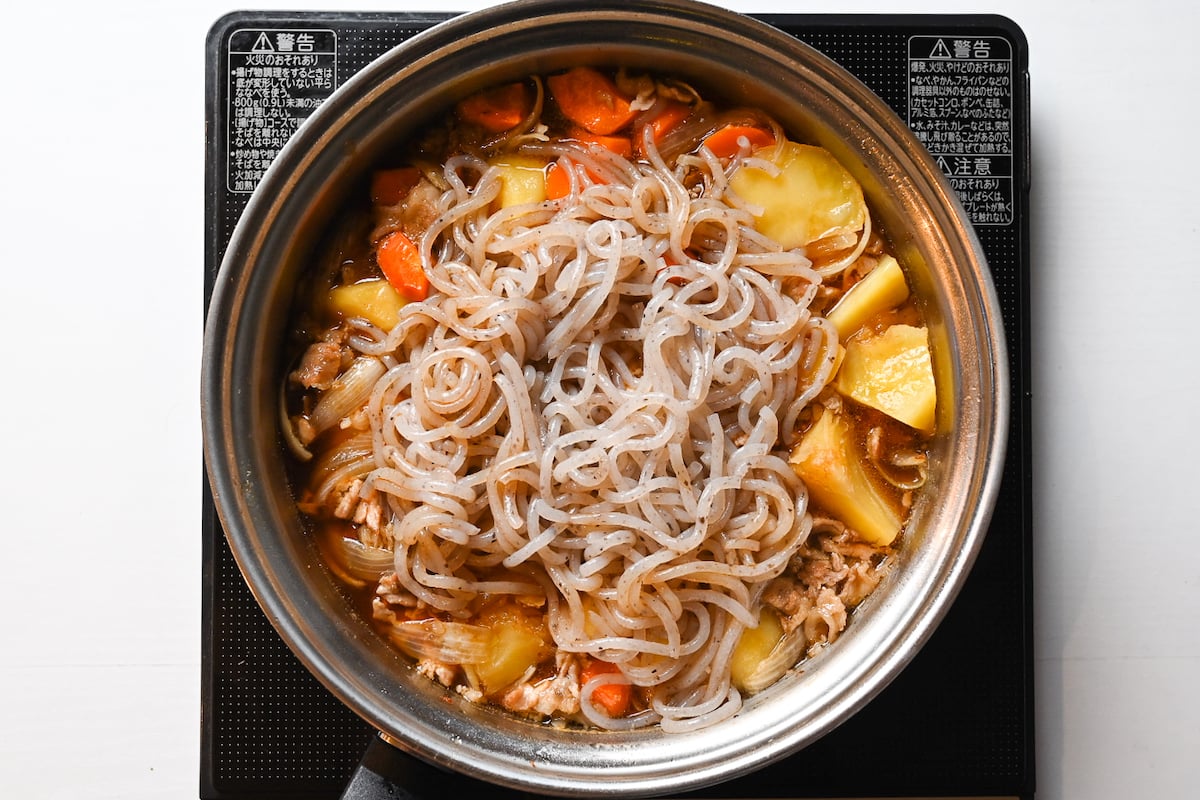
Rather than mixing, tilt the pan from side to side to spread the soy sauce around. Try to refrain from mixing as this can break the vegetables.
Place the drop lid back on and simmer for another 5 minutes.
If you stir the ingredients too much while simmering, the potatoes can fall apart. There is no need to stir frequently, as the potatoes will not burn if they are cooked with low heat until the liquid comes to a boil. If necessary, mix as gently as possible.
This is optional, but if you have time, I recommend leaving the nikujaga to cool and reheating it before serving.
You might wonder, “What’s the point?” But when making nimono (Japanese stew) dishes, the flavors soak in better when cool. To take advantage of this, let the dish cool for at least one hour after cooking to allow the flavors to soak in, then reheat right before eating.
Before the nikujaga finishes cooking, remove the stringy part of the snow peas by pinching one end and pulling the string out.
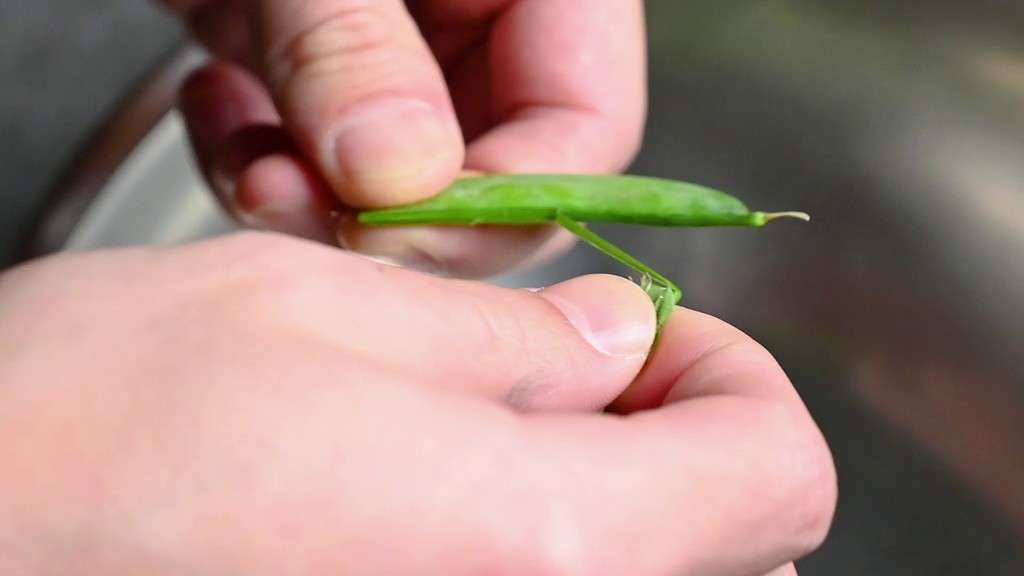
Blanch them in boiling water for 1 minute.
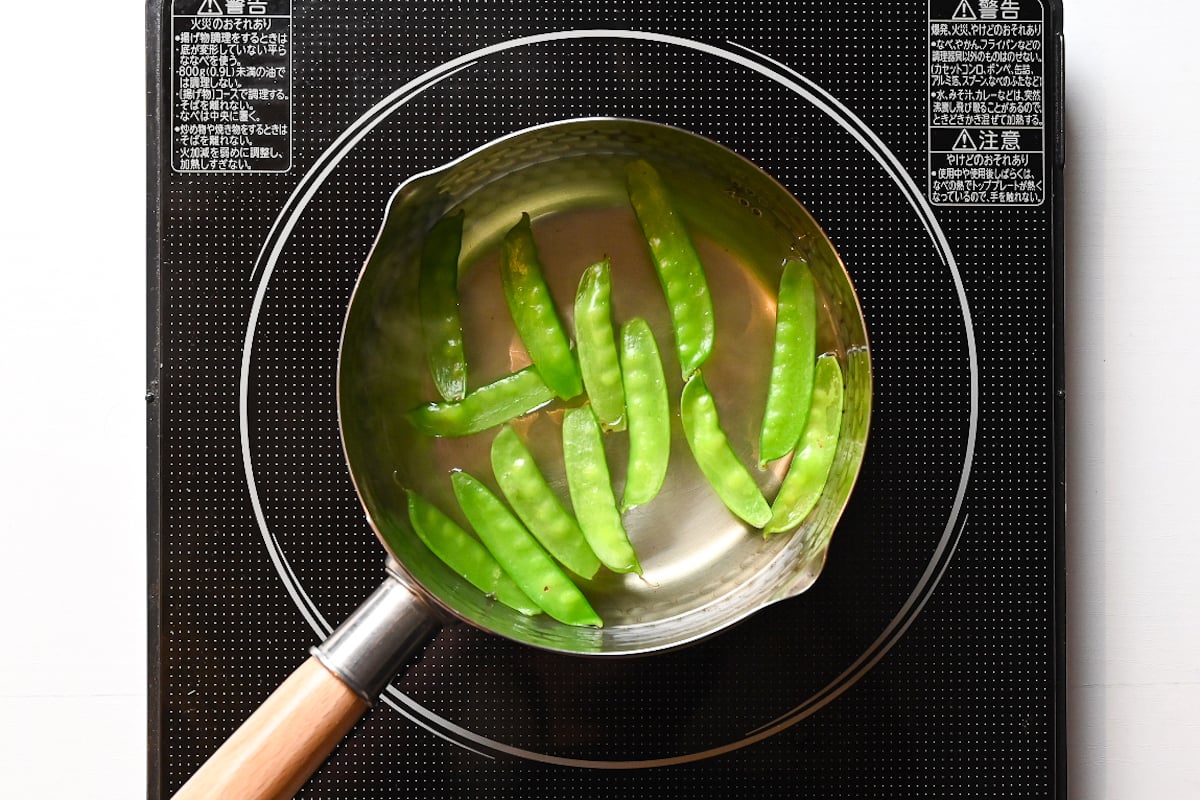
Remove from the heat and drain the water. Rinse with cold water (so that they’re cool enough to touch) and cut them into diagonal pieces.
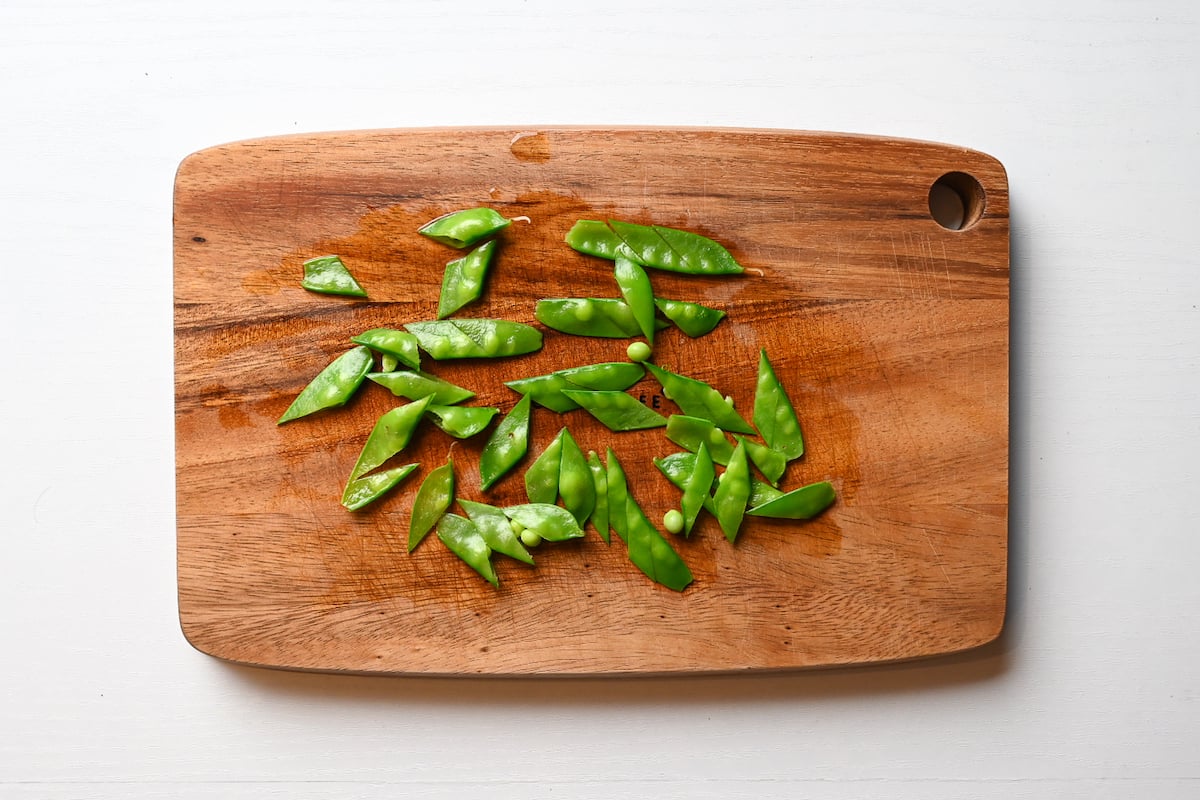
Take off the drop lid and use a spoon or ladle to scoop the broth and pour it over any vegetables that are exposed and poking out of the broth. Repeat for a few minutes.
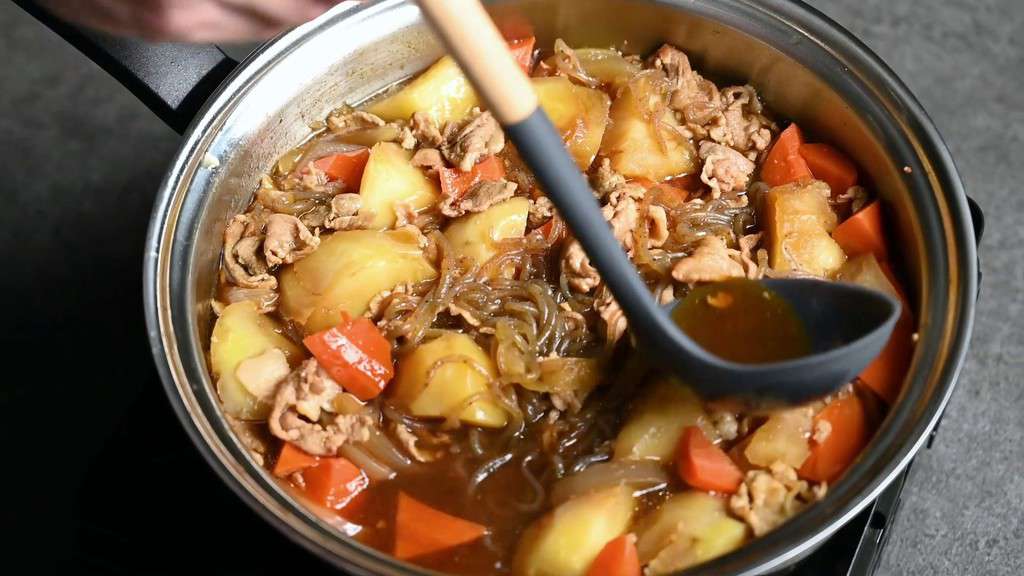
I like to add a little extra soy sauce right at the end. You might wonder why I don’t just add earlier, but the soy sauce used earlier has been cooked and absorbed into the ingredients and broth. An extra bit of soy sauce at the end gives the broth an extra boost of flavor. I use 2 tsp, but you can taste test and add more if you like.
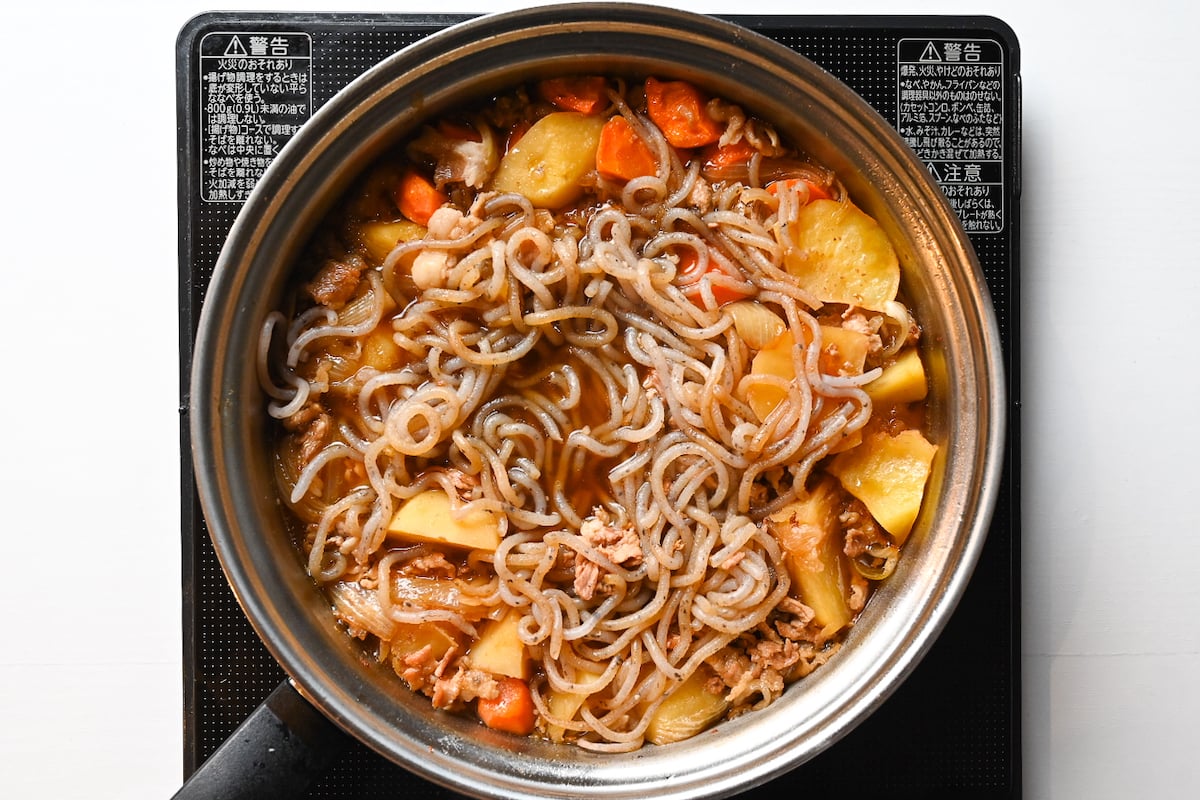
When the nikujaga is ready, place it in serving bowls and sprinkle with the blanched snow peas.
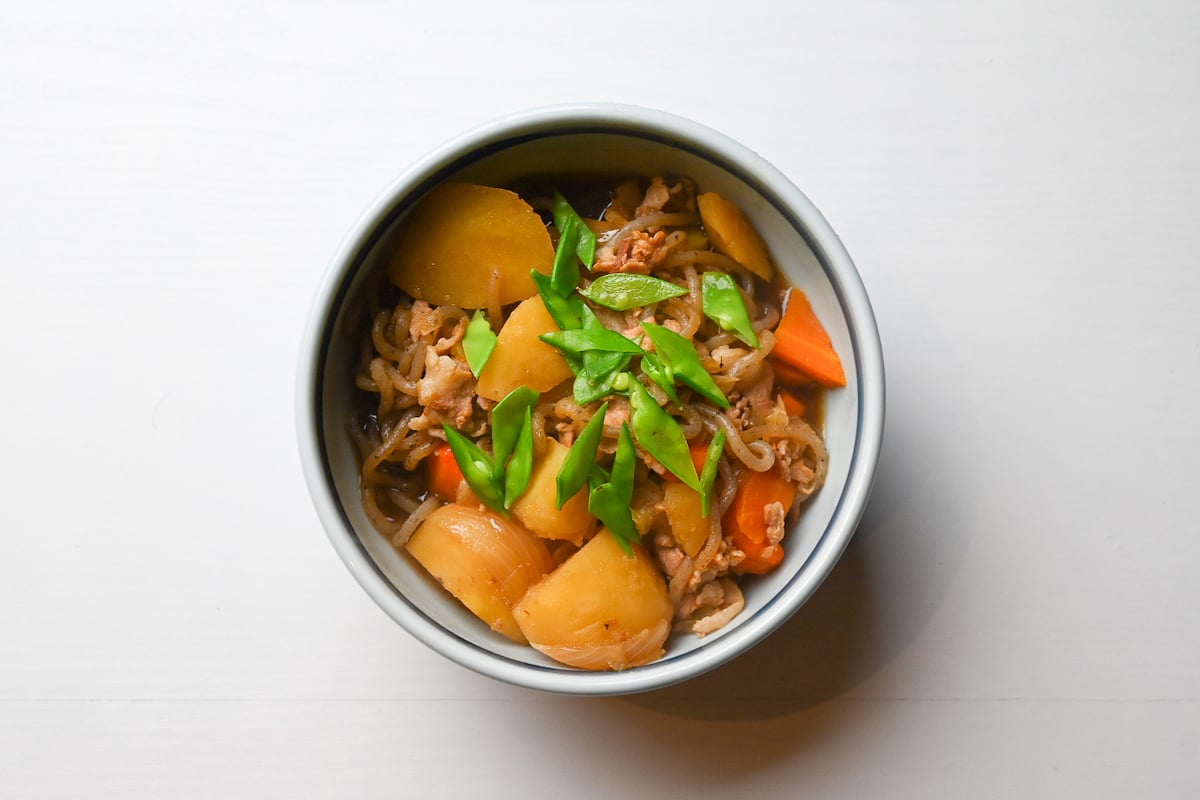
And enjoy!
Jump to Full Recipe Measurements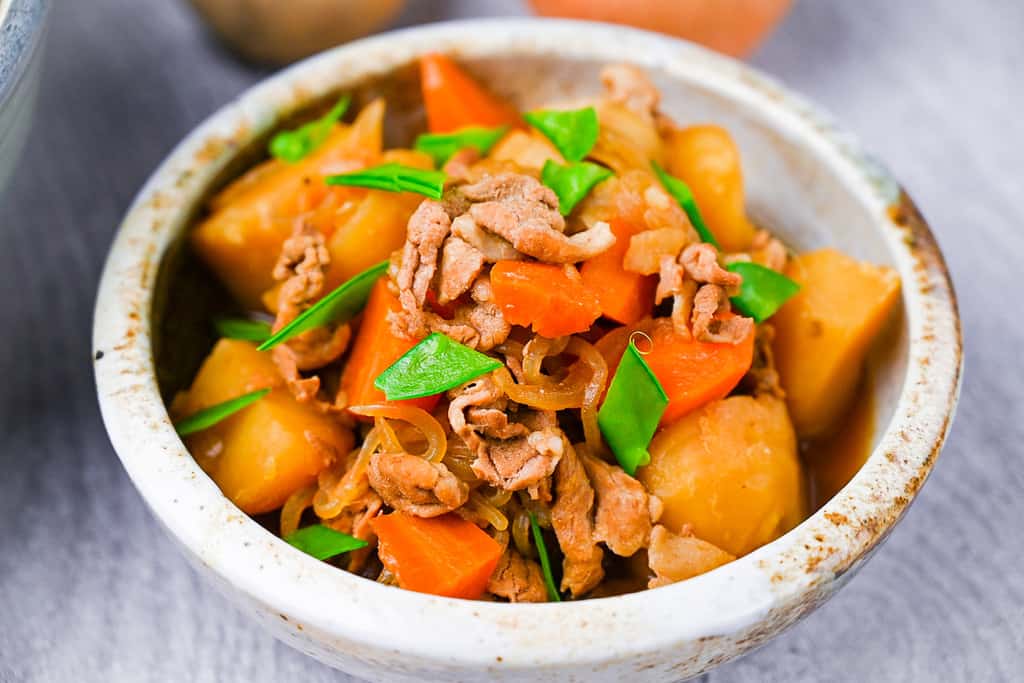
FAQ
The origin of Nikujaga, a beloved Japanese dish, remains a mystery with no definitive theory. However, a fascinating tale dating back to the 19th century in Portsmouth, England may shed some light on its beginnings.
In this story, a Japanese student living in Portsmouth frequently savored the flavors of English beef stew. Upon returning to Japan, he requested a chef recreate the dish. The chef, unfamiliar with beef stew, had to rely on the student’s description of its taste and improvise using locally available ingredients, such as soy sauce and mirin.
While the resulting dish didn’t quite resemble the taste of traditional English beef stew, it eventually evolved into its own unique creation, now known as Nikujaga. Some skeptics argue that this story is purely fictional, leaving the true origin of Nikujaga uncertain. However, as a Japanese person who lived in England, I find this intriguing connection between the two cultures to be quite captivating!
Do you use pork or beef in nikujaga? You may be wondering. The simple answer is that both are authentic and real Japanese nikujaga. Then what’s the difference between pork nikujaga and beef nikujaga? Is it to do with personal preference? Well, it depends on the regions within Japan!
Many surveys suggest that meat preference is divided between East and West. As some of you might already know, I’m from Aichi prefecture, which is right in the center of Japan (geographically). Interestingly, we seem to be on the border between pork and beef. But even though this map above suggests Aichi uses 53.7% pork and 46.3% beef, I have always remembered nikujaga as a pork dish.
Interestingly, the result in the neighboring prefecture can be the complete opposite! Rest assured, the recipe is delicious whether you use beef or pork.
I recommend light, refreshing side dishes like miso soup, hiyayakko (cold tofu), pickles, or cucumber salad and wakame salad to go with nikujaga. These sides complement the dish’s flavors, creating a balanced meal.
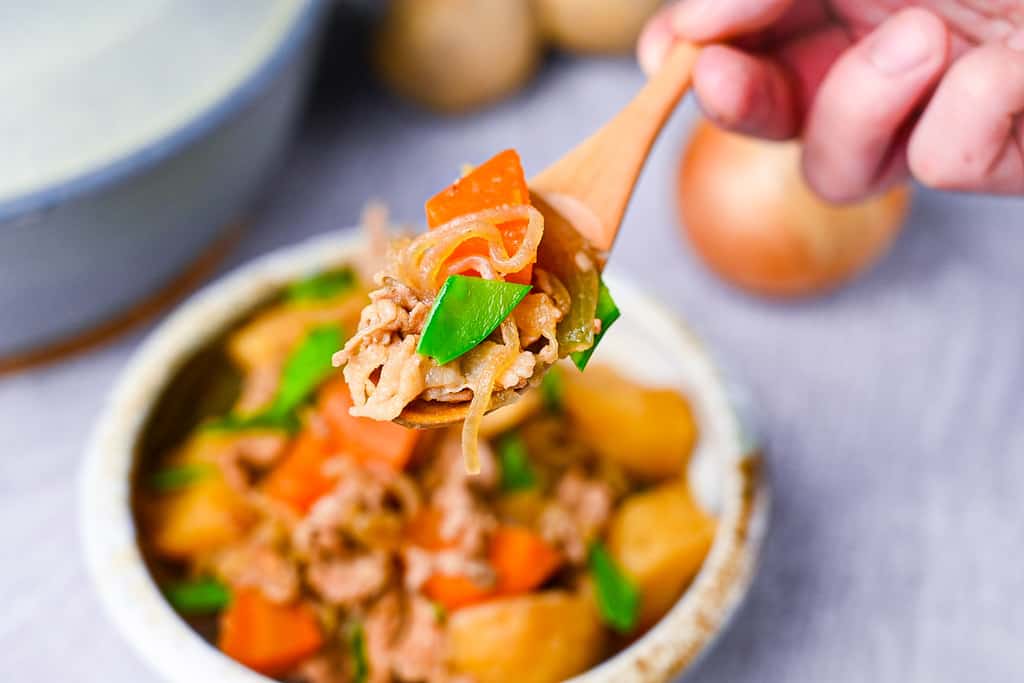
I hope you enjoy this Nikujaga recipe! If you try it out, I’d really appreciate it if you could spare a moment to let me know what you thought by giving a review and star rating in the comments below. It’s also helpful to share any adjustments you made to the recipe with our other readers. Thank you!
More Japanese Stew Recipes
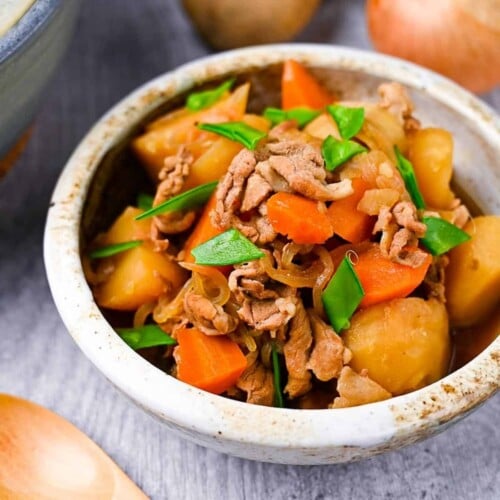
Authentic Nikujaga (Japanese Meat and Potato Stew)
Ingredients
- 300 g potato waxy type, approximately 3-4cm cubes
- 120 g carrot
- 100 g onion
- 200 g thinly sliced pork belly or thinly sliced beef
- 1 tsp cooking oil
- 400 ml dashi stock
- 1 tbsp light brown sugar
- 50 ml mirin
- 50 ml sake
- 100 g konjac noodles (shirataki) optional
- 40 ml Japanese soy sauce (koikuchi shoyu)
- 8-10 snow peas to garnish
- 2 tsp Japanese soy sauce (koikuchi shoyu) added seasoning at the end
My recommended brands of ingredients and seasonings can be found in my Japanese pantry guide.
Can’t find certain Japanese ingredients? See my substitution guide here.
Instructions
- First, peel 300 g potato and cut them into quarters. Soak them in a bowl of cold water to remove the excess starch.

- Peel 120 g carrot and 100 g onion, cut the carrot into rough chunks and the onion into medium wedges.

- Cut 200 g thinly sliced pork belly into bitesize pieces.

- Take a pot and heat it on medium. Once hot, add 1 tsp cooking oil and add the meat to the pot. Fry until both sides of the meat are seared.

- Once seared, add the onion and stir fry for 1 minute.

- Add the potatoes and carrots to the pot and mix thoroughly.

- Add 400 ml dashi stock and bring it to a boil.

- Once boiling, add 1 tbsp light brown sugar, 50 ml mirin and 50 ml sake. Turn the heat down to a simmer and place a drop lid on top, touching the broth. Simmer for 30 minutes.

- Boil 100 g konjac noodles (shirataki) in a separate pot for 2-3 minutes and then drain the water to remove any unwanted odor.Once the 30 minutes are up, remove the drop lid and add 40 ml Japanese soy sauce (koikuchi shoyu) and konjac noodles to the pan. Tilt the pan/pot from side to side to move the soy sauce around without mixing (avoid mixing).

- Place the drop lid back on and simmer for another 5 minutes.Optional step: For the best flavor, turn off the heat and allow it to cool completely. Once cool, reheat on the stove over a medium setting until boiling.

- Remove the stringy part of 8-10 snow peas and blanch for 1 minute in a separate pot of boiling water.

- Remove them from the pot, cool with cold running water and cut them into diagonal pieces.

- Remove the drop lid and use a spoon or ladle to scoop the broth and baste it over the exposed vegetables. Add 2 tsp Japanese soy sauce (koikuchi shoyu) and tilt the pan to distribute it through the rest of the broth.Simmer for a few more minutes and taste-test the soup. (You can add more soy sauce to taste.)

- Once you’re happy with the taste, dish up. Sprinkle with the cut snow peas to garnish.

- Enjoy!
Video
Notes
- Use thinly sliced pork or beef according to preference.
- You can use any snow peas or green beans, whichever you prefer.
- We sometimes add konjac or renkon (lotus root) in Japan, if you can get hold of these ingredients then you should try adding them too!
- Serving suggestions: spinach ohitashi, freshly cooked rice, and pickles.





The recipe says green beans, but the pictures show snow peas. I think peas make more sense than green beans.
You’re right, my mistake!
I’ve corrected it now, thank you. 🙂
Delicious! thank you for your help!
Hi Helena,
Thank you for making this recipe! I’m glad you liked it! 🙂
Yuto